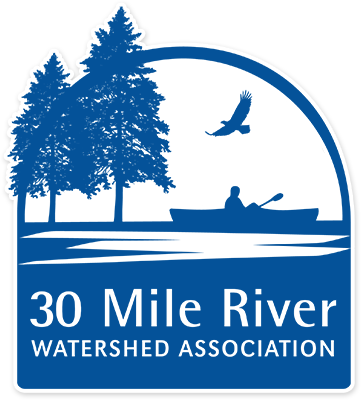Stories of Watershed Impact | 2024
May 2025
There’s positive momentum building here in our watershed. People are stepping up to protect the lakes they love—individuals, road associations, lake associations, and our towns. And at 30 Mile, we’re growing—not just with our new space in Mt. Vernon, but in the depth and reach of our work.
At a time of great uncertainty at the national level, we’re reminded that real, meaningful change happens at home. That’s why we’re doubling down on our commitment to protecting the lakes and ponds that define this region—and on building a stronger, more connected community to support them.
We’ve seen the effects of climate change in our watershed in recent years: heavier storms, damaged roads, polluted runoff, and algal blooms. Invasive species continue to spread in Maine, and are in our watershed. These challenges are real—and they’re here. But so is the opportunity to respond with purpose and action.
Over the past year, we’ve done just that. We’ve expanded our support for towns working to build storm-resilient infrastructure. We’ve continued the fight against invasive species. And we have completed the first phase of creating our new home base in Mt. Vernon Village. This space is already becoming what we hoped it would be—a welcoming place for our community to gather, learn, and take action together to protect the waters we all care about.
Our lakes have a unique ability to bring people together. They remind us of what we have in common, and what’s worth working for. By strengthening 30 Mile, we’re helping to ensure that this place—and this community—can meet
the challenges of the moment and thrive.
Thank you for being part of this work. We are so grateful for your support, and we’re excited to see what we can accomplish together in the year ahead.
With appreciation,

Shop our Online Store
Visit our new online store, here. All proceeds directly support 30 Mile’s work across the watershed.
Sign up for our Monthly Newsletter
Receive our newsletter – Watershed Roundup – in your inbox each month to stay up-to-date on Watershed news and events all year long. Join today!
30 Mile Taking Action
Our programs promote long-term, sustainable change. We directly protect and monitor lake health, assess and work to reduce land use impacts, and provide educational and recreational opportunities to foster stewardship.
Our first line of defense
Our paid staff and 49 volunteer Courtesy Boat Inspectors (CBIs) conducted 3,801 inspections from May to October, contributing 525 hours to protect…read more
Bladderwort in Tilton Pond
This was our first full season managing the invasive swollen bladderwort infestation in Tilton Pond. Our work included…read more
9th Season Monitoring Lake Health
We collect extensive data to track the health of our lakes and ponds. We measure water clarity, temperature, dissolved oxygen, phosphorus, and other parameters…read more
Lake-Protection Projects for Androscoggin and Parker
In 2024, we began a two-year project on Androscoggin Lake, funded in part through a grant by the U.S. Environmental Protection Agency under Section 319 of the Clean Water Act…read more

Through our monthly e-newsletter, Watershed Roundup (1650 subscribers), and our Facebook and Instagram pages, we inform and educate the public about lake protection and promote opportunities for community involvement. In 2024, 12,583 viewed our e-newsletter with a 61% open rate. Sign up to stay in the know!

In May, we held a training for 17 CBI volunteers on Echo Lake. CBIs are our first line of defense against invasive species, and volunteer CBIs are essential, enabling us to significantly expand the coverage at boat launches.
Catching invasives early
Nearly 100 volunteers across nine lakes and ponds throughout the watershed completed surveys for aquatic invasive plants…read more
Studying and addressing algal blooms
Androscoggin Lake suffered its third lake-wide algal bloom in four years. To study its causes, we completed a third season of intensified monitoring of the lake and its tributaries…read more
Being LakeSmart in the watershed
30 Mile is a regional LakeSmart “hub,” providing technical
support for this statewide program that educates lakefront homeowners to help them manage their properties in ways that protect water quality…read more
15th Annual Paddle Trek
Sixty paddlers enjoyed perfect weather and conditions for our 15th Annual Paddle Trek on July 27th. In a rare occurrence, several streams were passable by boat…read more
Milfoil in Androscoggin Lake
For the 4th season, our staff continued managing invasive milfoil on Androscoggin Lake, surveying 260+ hours…read more

In May, we co-hosted an invasive plant patrol workshop led by Lake Stewards of Maine, held in Mt. Vernon. In August, we led a Plant Paddle and I.D. workshop on Lovejoy Pond. Volunteers gained hands-on experience and learned the basics of plant identification, the differences between invasive and native plants, and surveying techniques.
Photo: Lidie Robbins examines aquatic plants with local volunteers at the workshop in Mt. Vernon.
Funding and Technical Support for Vienna’s Roads
30 Mile wrote two successful grant proposals for the Town of Vienna to address key road crossings that have repeatedly suffered from severe washouts and road failures, and significantly threaten water quality in downstream lakes…read more
Building Better Buffers
A core part of our work is assisting landowners by recommending lake-friendly practices to reduce harmful erosion…read more

30 Mile staff participate in all of the lake associations’ annual meetings and present on topics including invasive plants, water quality, and more.
Reducing Runoff
Lake-Protection Projects for Androscoggin and Parker
In 2024, we began a two-year project on Androscoggin Lake, funded in part through a grant by the U.S. Environmental Protection Agency under Section 319 of the Clean Water Act, and administered by Maine DEP in partnership with EPA. In 2024, we were awarded a similar grant for Parker Pond for work in 2025-2026. These grants fund projects to help communities restore and protect priority waters by reducing erosion and polluted runoff. Through this work, we are able to bring significant funding and technical expertise to towns, road associations, and landowners to take on important lake-protection projects that otherwise wouldn’t be possible.
Androscoggin grant
Parker grant
Fighting Invasives
Our first line of defense
Our paid staff and 49 volunteer Courtesy Boat Inspectors (CBIs) conducted 3,801 inspections from May to October, contributing 525 hours to protect Androscoggin Lake, Echo Lake, Flying Pond, Minnehonk Lake, and Parker Pond. Not only do our CBIs prevent invasive hitchhikers from getting into our lakes; they educate all boaters about the threat of invasive species.
boat inspections performed in 2024
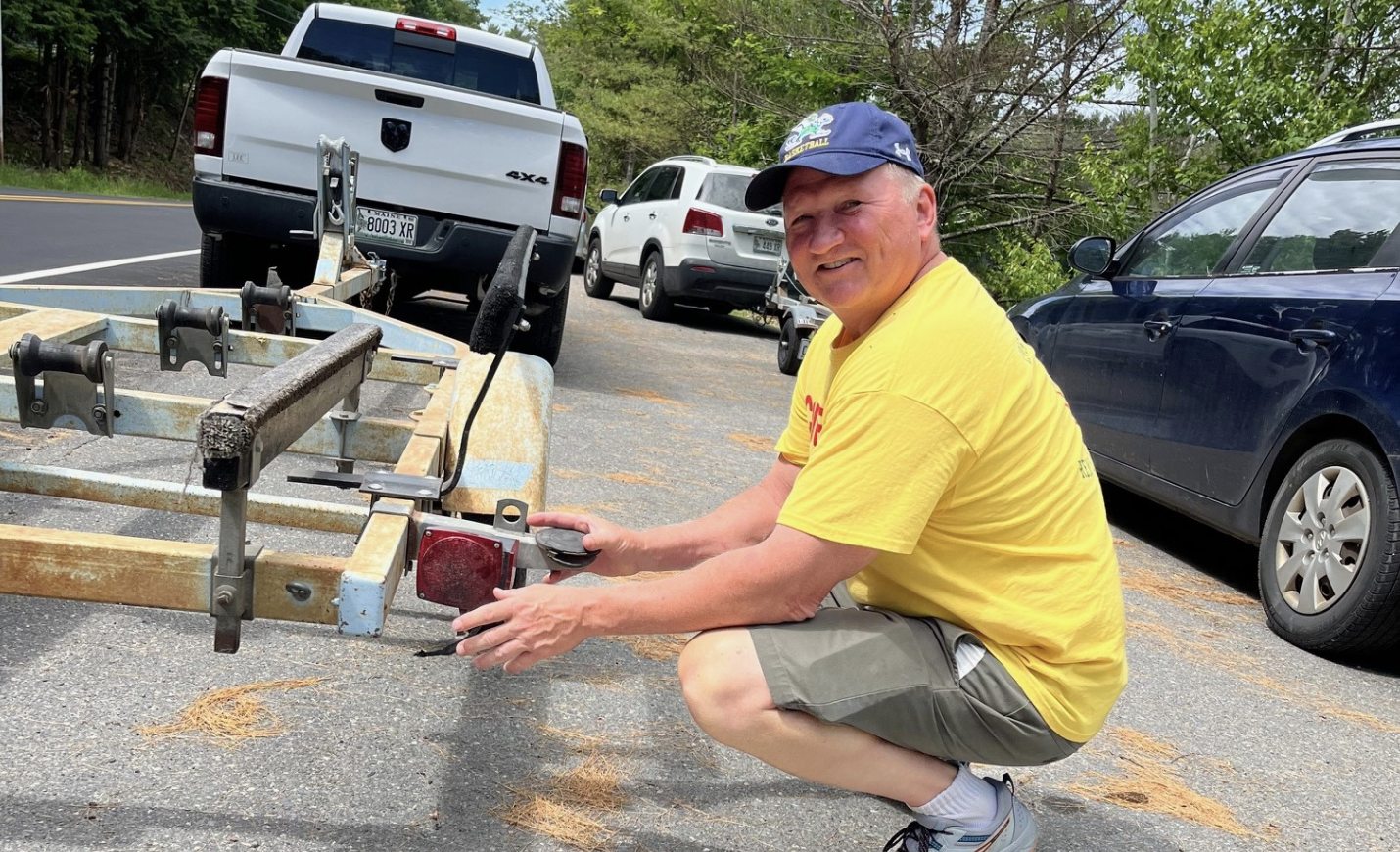
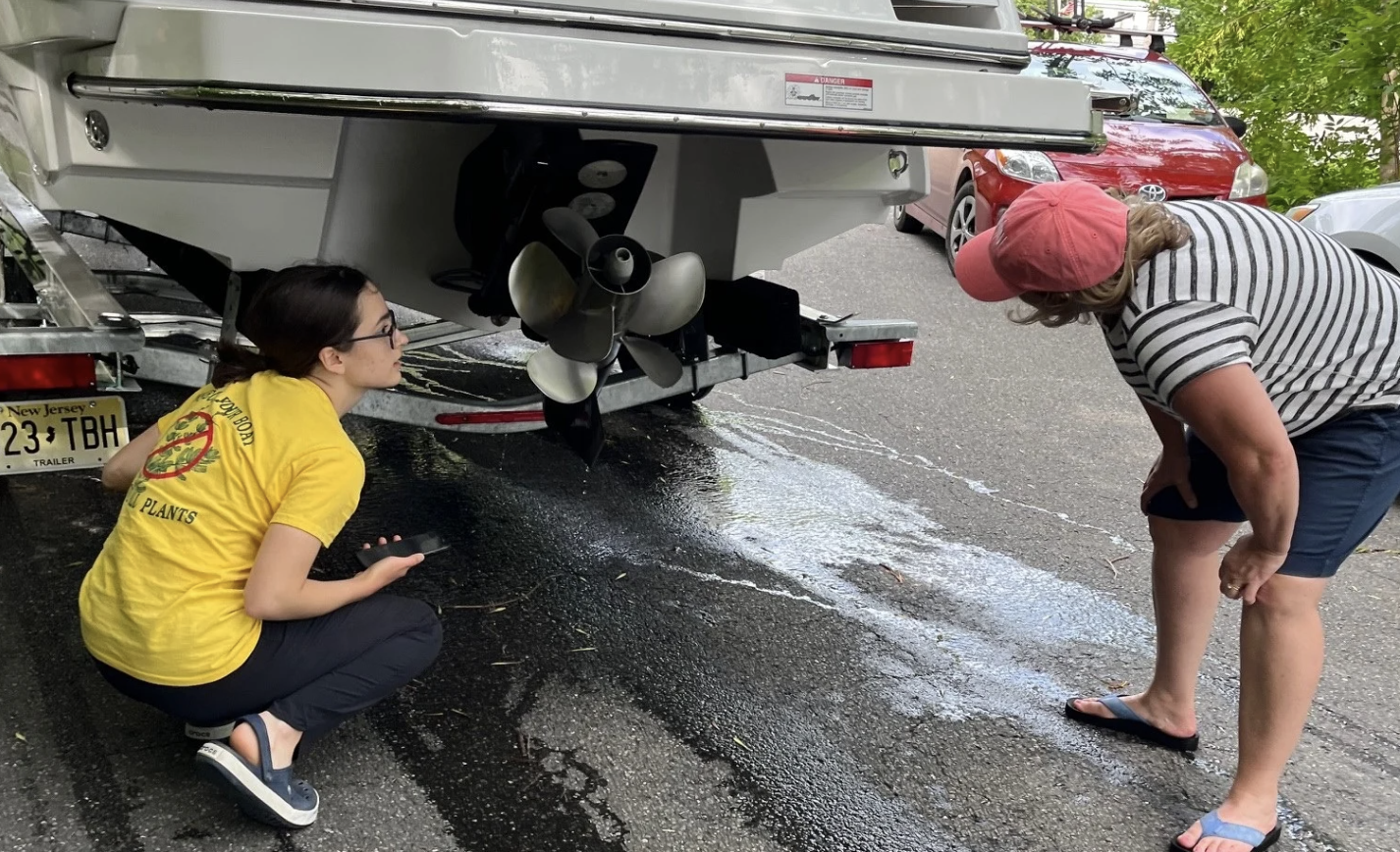
Photos: Members of our 2024 CBI team: Flying Pond volunteer Bill Murphy and staff member Lina Martinez.
Reducing Runoff
Funding and Technical Support for Vienna’s Roads
30 Mile wrote two successful grant proposals for the Town of Vienna to address key road crossings that have repeatedly suffered from severe washouts and road failures, and significantly threaten water quality in downstream lakes. A grant of $50K from the Maine Infrastructure Adaptation Fund (Maine DOT) will be used to hire an engineer to complete the scoping, design, and permitting to upgrade three stream crossings on town roads: Jesse Ladd, Kimball Pond, and Trask.
The second grant was Vienna’s first Climate Action Grant through Maine’s Community Resilience Partnership. This $50K grant will fund an engineered design at a fourth high-priority culvert crossing on Tower Rd, along with the project management, grant writing, and cash match needed to apply for grants to support the construction of these costly culvert upgrades.
Fighting Invasives
Catching invasives early
Nearly 100 volunteers across nine lakes and ponds throughout the watershed completed surveys for aquatic invasive plants in 2024! Annual invasive plant surveys are critical for catching new infestations early. Our staff provide key support to each volunteer plant patrol team through identification expertise, training opportunities, survey assistance, and more.

Photos: Silas Mohlar trains volunteers at the workshop on Lovejoy Pond.
Fighting Invasives
Milfoil in Androscoggin Lake
For the 4th season, our staff continued managing invasive milfoil on Androscoggin Lake, surveying 260+ hours and removing all milfoil found. So far, we have successfully prevented its spread. We began using benthic barriers as a control strategy and will use them heavily in 2025. We will also work with the lake association volunteers to complete a full lake survey.
How to spot Variable milfoil: Look for feather-divided leaves and a bottle brush appearance.
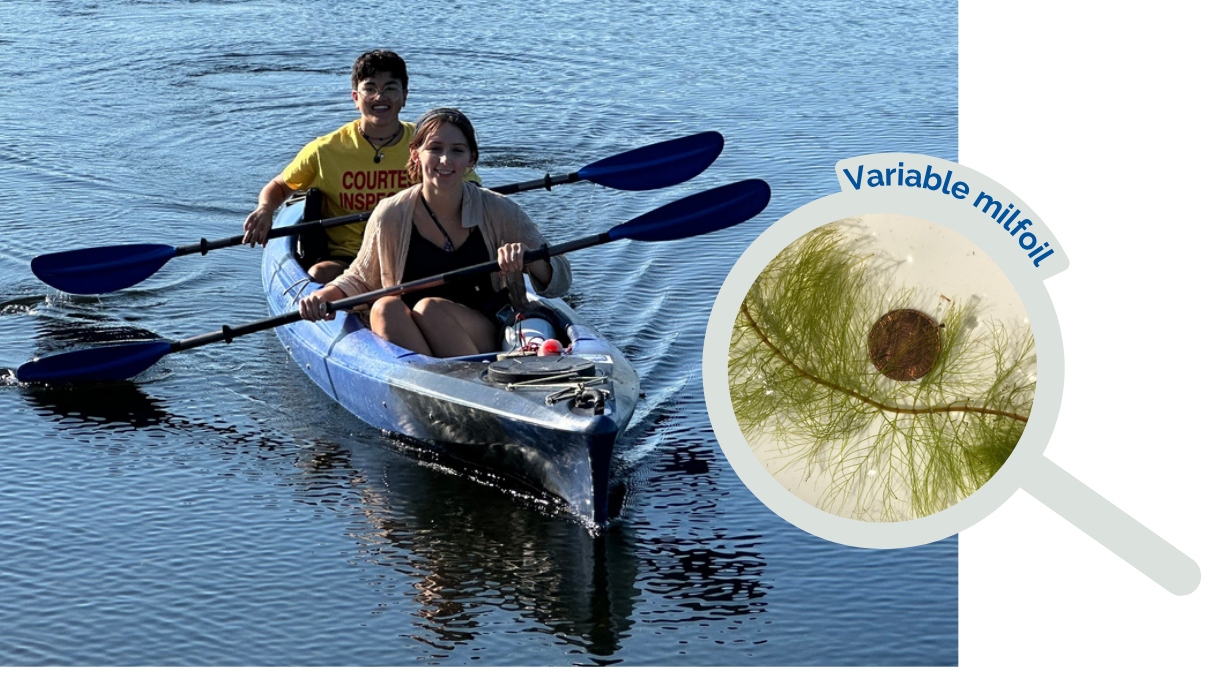
Photos: (1) Our staff conduct weekly surveys by kayak to search for invasive variable milfoil in Androscoggin Lake. (2) Variable milfoil has feather-divided leaves and a bottle brush appearance.
Fighting Invasives
Bladderwort in Tilton Pond
This was our first full season managing the invasive swollen bladderwort infestation in Tilton Pond. Our work included installing a fragment net at the pond’s outlet to reduce risk to downstream waters, increasing surveying on downstream David Pond, monitoring plant growth on Tilton, and supporting volunteer survey and removal efforts.
How to spot Swollen bladderwort: Look for wagon wheel-shaped floats and yellow flowers.
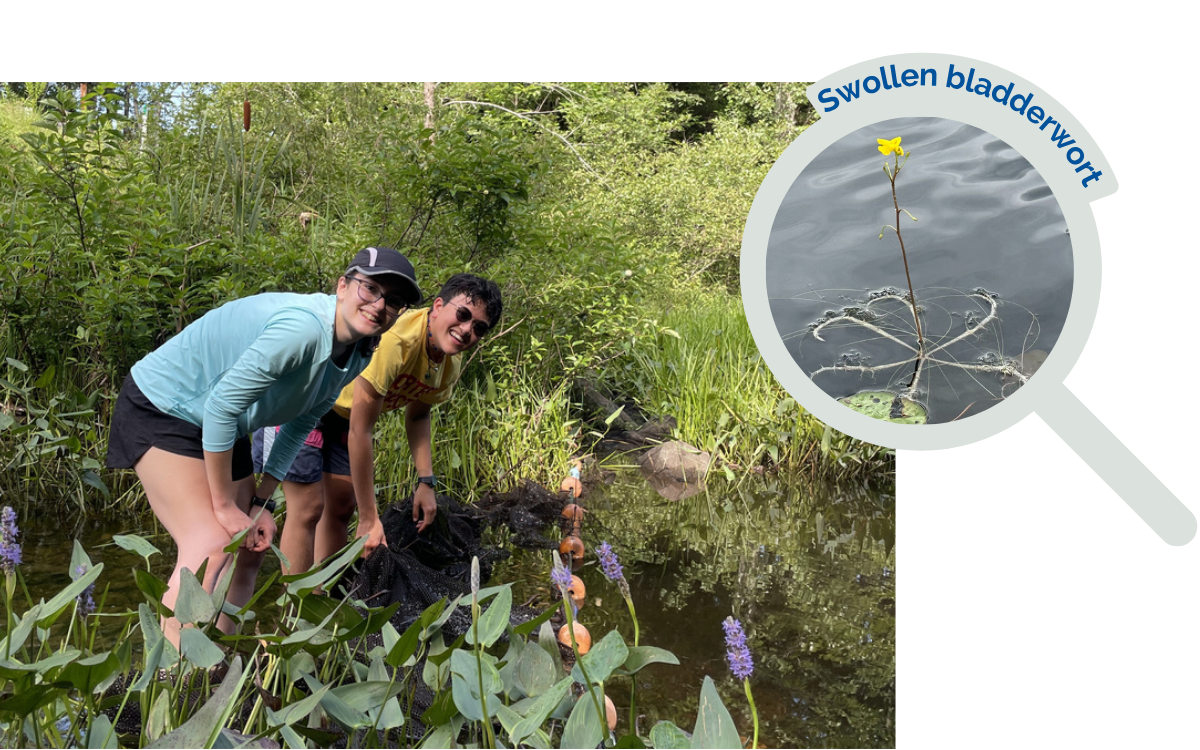
Photos: (1) Our team install and monitor a net in Tilton’s outlet stream to capture floating plant fragments and help prevent its spread to downstream David Pond. (2) Swollen bladderwort has wagon wheel-shaped floats and yellow flowers.
Water Quality Monitoring
9th season monitoring lake health
We collect extensive data to track the health of our lakes and ponds. We measure water clarity, temperature, dissolved oxygen, phosphorus, and other parameters. Our data help us identify trends in declining water quality so that we are prepared to take action.
Our staff, alongside 35 volunteers monitored 13 lakes and ponds, from May-October.
Photos: (1) Whitney Baker takes a clarity reading. (2) Volunteer Gary Phillip and Silas Mohlar monitor Echo Lake. (3) Silas collects water samples. (4) Volunteer Leslie Burhoe transports us to the Androscoggin Lake monitoring station.




monitoring trips
samples collected
Secchi (water clarity) readings
Responding to Threats
Studying and addressing algal blooms
Androscoggin Lake suffered its third lake-wide algal bloom in four years. To study its causes, we completed a third season of intensified monitoring of the lake and its tributaries, including algae analysis and phosphorus studies. Throughout this early and prolonged bloom, we released updates, notices, and educational information for the public.
In collaboration with Maine DEP, we continue to analyze data, identify additional data needs, and study the problem. We have begun taking steps to improve the lake’s water quality, including supporting watershed remediation projects with funding and technical assistance, in order to reduce polluted runoff.

Supporting Landowners
Being LakeSmart in the watershed
30 Mile is a regional LakeSmart “hub,” providing technical support for this statewide program that educates lakefront homeowners to help them manage their properties in ways that protect water quality. Our watershed’s five volunteer lake teams and our staff conduct free site visits for landowners. In 2024, together we completed property evaluations for 11 landowners and delivered LakeSmart education throughout the watershed to build a conservation ethic across the lake community.
Photos: (1) Whitney Baker trains members of Flying Pond’s volunteer LakeSmart team. (2) Flying Pond landowners Debbie and Mark Boll receive their LakeSmart award from members of Flying Pond’s team.


Reducing Runoff
Building Better Buffers
A core part of our work is assisting landowners by recommending lake-friendly practices to reduce harmful erosion. In 2024, we launched a new initiative to improve shoreline buffers, planting over 300 live stakes on shorefront properties.
Photos: (1) Whitney Baker plants live stakes along a lakefront property that was lacking a vegetative buffer. (2) Planting live stakes – cuttings from native woody shrubs – is an inexpensive way to build a buffer to protect a lake from runoff.


15th Annual Paddle Trek
for our 15th Annual Paddle Trek on July 27th. In a rare occurrence, several streams were passable by boat, reducing the number of portages and creating a unique experience for this year’s event. Many thanks to Lakepoint Real Estate for their sponsorship, the Mount Vernon and Fayette fire departments for traffic control, and over 30 volunteers for making the day run so smoothly.
Thank you, Trisha Cheney for capturing our fun filled day!


How can you make a difference?
A New Home for 30 Mile

30 Mile’s new home before renovations began.

In 2024, we completed Phase I construction of our new center for lake protection in Mt. Vernon Village, renovating both floors of the barn.

The renovation began in March with a new roof.

Volunteers framed a new bathroom in the garage. New stairs provide access to the 2nd floor.

In the summer and fall, new windows and doors were installed. Walls, floors and the roof were strengthened to code. Volunteers painted the exterior.

After the wiring, plumbing, insulation and sheetrock were completed, volunteers painted the walls.

Then volunteers installed flooring and trim.

In January, we moved out of our Farmington office and into our new space!

30 Mile’s new home after Phase I. Plans for Phase II will begin in spring 2025.
A Community Effort
It takes a whole community to protect our watershed.
Thank you to our 2024 Volunteers!
Volunteers are a vital part of 30 Mile’s team, generously contributing thousands of hours to make this work possible. They fill key roles across all areas of our work, including boat inspections, water quality monitoring, LakeSmart evaluations, invasive plant surveys, watershed surveys, office support, our Board of Directors, and more.
Volunteers
Volunteer hours
“For me, as a retired geologist, the water quality monitoring is both educational and fun. I now have a much better understanding of the natural cycles of my lake and the potential impacts of both natural and human-induced changes. I no longer just look at the lake as a pretty body of water that I want to protect, but rather I feel like I can see how it breathes and hear its heartbeat.”

We dedicate this report to Andy Tolman (1948-2024), a vital member of 30 Mile’s Board for seven years. Andy cared greatly about our mission, even though he didn’t own lakefront property himself. As a retired hydrogeologist, an extremely active community member, and someone with a great deal of experience working with small organizations, he was invaluable on our team. He was always one of the first to volunteer for whatever needed to be done, and served as Chair and Treasurer. In 30 Mile’s history, Andy stood out as one of our best – a kind, gentle, and patient man who brought a lot of wisdom, dedication and generosity to his work. We loved and respected him and miss him greatly.
Thank you to our donors!
It takes a whole community to protect our watershed.
Thank you to ALL of the generous lake lovers who supported 30 Mile in 2024! Your gifts of all sizes demonstrate your commitment to the lakes, ponds, and streams in our watershed. We are grateful for you and the many ways you show up as a community to help care for these precious waters.
Raised from individuals and businesses in 2024 for our Annual Fund
Donors across 15 lakes and ponds
2024 Financial Report


Notes: (1) Income of $47,573 from the Capital Campaign and Save Androscoggin Campaign was restricted to be used in 2025 for the building renovation and projects on Androscoggin Lake, not 2024 operational expenses. (2) 13% of income raised was spent on development. This is within range for best-practices for nonprofits (10-15%), and below range for an organization in a growth phase (15-25%), like 30 Mile.
Photo Credit: Ned Van Woert (Banner)
